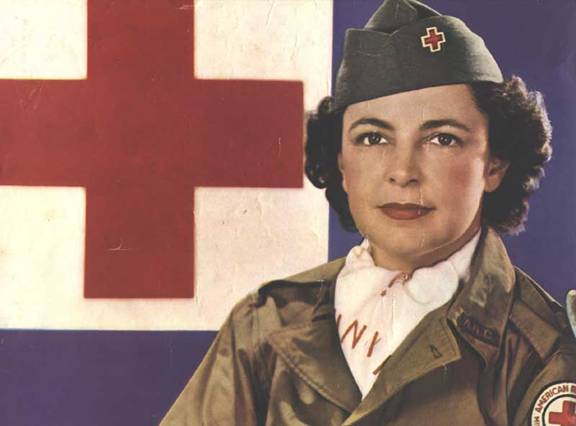
Some
while ago I posted pictures on the forum of my own 352B1 at a military
vehicle show, displaying the Red Cross symbol representing part of a
display for the 514th Red Ball Express re-enactment group. The
WW2 ARC Clubmobile “Springfield” is also portrayed within this group.
The photographs themselves raised much interest in the re-enacting
community especially amongst the MV paparatzi
presumably because it made for good copy.
Following the publication of a new book in 2008 featuring pictures of this
colourfull Red Cross jimmy, and aware that the annual “World Red Cross
and Red Crescent Day” was up coming again on the 8th May, I
thought I’d do a little further research, to highlight the invaluable
work this institution does, around the world.
It occurred to me that I knew very little of the origins of this
well established symbol, and I wanted to find out more. It turned out to
have been a great history lesson, and frankly some of the things I was to
learn surprised me. I was alarmed at what I discovered and thought it may
be of interest to other re-enactors equally keen to display this
significant and often misunderstood symbol.
I was asked by several enthusiasts to “say a few words”.
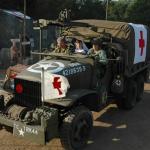
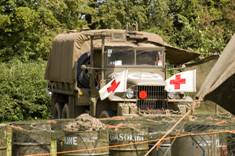
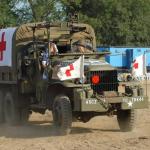
The
Red Cross & Its Emblem.

Red Cross Emblem
The Red Cross Emblem, was officially approved in Geneva, Switzerland and
declared in Article 7 Chapter V11 of the Geneva Convention of 1864, just
one year after the International
Committee of the Red Cross (ICRC) was founded.
The emblem chosen by that committee was a
simple red cross of no specific proportion but styled on the Greek
Cross set humetty on a white
background. This first Geneva Convention refers to the cross as a
“Protection Symbol” and “Distinctive Emblem”, and its purpose was
to introduce an easily recognisable and universal sign of neutrality.
Dr Louis
Appia and General Henri Dufour founding
members of the International Committee chose the design to honour Henry
Dunant, the founder of the Red Cross, and his home country Switzerland.
The design was based on the national Flag of Switzerland with colours
reversed.

Flag
of Switzerland
(Unusually
the national Flag of Switzerland is only one of two square shaped flags of
a sovereign state, the other being the Vatican City).
The
proprtions of the elements of this crux
immissa quadrata (Greek cross), were deliberately not defined.
Provided it was set humetty
(heraldic) any size could be used. Neither was the shade of red of the
cross, specified. This was to allow battlefield designs to be prepared
using available materials, without the incumberance of measurements.
It was not until 1881 that The Red Cross flag was first officially
flown in the
USA
(the year the U.S. Red Cross was founded), when Clara Barton flew the flag
in
Dansville
,
New York
, during an appeal for donations to help the victims of forest fires in
Michigan
.
To
digress for a moment, The Greek Cross when displayed “Voided”
(heraldic) is sometimes
interpreted to be composed of four turned Greek gammas (equivalent to the
letter "g:"). This is called a crux
gammata or cross gammadion,
a name it shares with the swastika when used in heraldry.
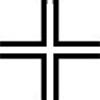
Greek cross
“Voided”
The irony in this is that
the same Greek cross displayed gammata rather
than quadrata
has historically been used as a different form of recognition
symbol, used on vehicles with intent other than those of humanitarian
visits.
(More
recently an unofficial
agreement has been reached within the Red
Cross & Red Crescent Movement that the shape of the cross should
be composed of five squares, but the size of the square still remains
unspecified. This was deliberate to prevent “misinterpretation” of a
sign that did not fully comply to the letter of the design)
Readers note:
Care
must be taken to ensure that although similar to Saint George’s cross
the red cross symbol is not confused with Saint George’s cross, which
differs in that its unequal horizontal and vertical elements both extend
to the edges of the flag

Georges.

Greek.
The Greek Cross is regular in shape with its vertical and horizontal
elements uniform and distinctly not extending to the edges. (In hereldry
this is known as: humetty).
This is
an important difference, and crucial that it be fully understood to avoid
uneccessary confusion, insult and misleading intention.

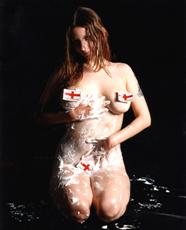
Originally, it was intended that only the Greek Cross was to be used as
the Humanitarian emblem of the Geneva Convention, but because the cross
was seen to have religious connotations by some within the Muslim
community, reminding them of Christianity and the Crusades, many Muslim
nations objected to this so they chose to adopt their own symbol, the Red
Crescent, which was more traditionally associated with Islam. It, like the
origins of the Red Cross Symbol, was derived from the the colour reversal
of a significant Muslim flag. The
Ottoman Flag, but set without the star. Again it was agreed that the
colour and dimentions of the crescent not be specified.

Red
Crescent
Although the red cross emblem was well established first being used by the
ICRC in the conflict between Russia and Turkey 1877-8, the introduction of
the alternative red crescent in 1919 led to the formation of a new
movement which became known as: The
International Federation of Red Cross and Red Crescent Societies,(IFRC).
The crescent symbol however was not officially adopted for use along side
the Geneva Cross until final agreement much later in 1929.
Independantly Persia was to secured the use of the red lion and
sun, while Siam made an attempt to use a red flame

Red
Lion
There have been a number of other suggestions through the years with
the following symbols suggested, a Red Palm for Syria and a Red
Rhinoceros for Sudan, a Red Archway for Afghanistan and a Red Lamb for
Congo. In
Asia
, there's a Red Wheel for
India
(along with a Red Swastika, also for
Sri Lanka
), a Red Sun and Strip for
Japan
, and a Red Cross and Flame for
Thailand
. In 1906 at
Siam
's request a Red Flame was approved, although it was never used. Also
approved in 1906 at the request of Iran, a Red Lion and a Red Sun.
Although in 1980 the Islamic Republic of Iran switched again, to the Red
Crescent.
Israel
continues to uses a Red Shield (Star) of David, even though it has not
been approved.
Confused? Well read on:
The modern and often-heard term International
Red Cross is itself a misnomer and is incorrect, as there is no
official organization existing bearing that name. In reality, the movement
consists of several distinct organizations that are legally independent
from each other, but are united within The
Red Cross and Red Crescent Movement, these
are:
International
Committee of the Red Cross (ICRC)

International
Federation of Red Cross and Red Crescent Societies (IFRC).

unless of course you’re Russian then the crescent is reversed

National
Red Cross and Red Crescent Societies.
 or
or
 changes
throughout the 192 member countries
changes
throughout the 192 member countries
The
Geneva Conventions.
The
Geneva Convention the body which strove to establish a symbol of
neutrality and humanitarianism, has itself undergone a number of
revisions. For the WW2 military enthusiast and those interrested in such
things the 3rd Convention of 1929
is perhaps the most significant for it was the version that was in effect,
throughout WW2. Full details
can be read here:
http://www.historyonthenet.com/WW2/geneva_convention.htm
.
The use
of the Red Cross emblem painted on D-Day helmets is entirely another
issue, and worthy of discussion in its own right. Readers can do their own
research to determine the history behind this, but are advised not to
accept anything originating from Hollywood, as being a good reference
works.
Following
WW2 the convention underwent several further revisions, necessitated in
part by the complex issues of international
“acceptablity” and political “correctness”. Concequently the
issues raised by the “symbol” was addressed again. In an attempt to
clean up the acceptability and respectability of this Humanitarian Symbol
the Convention the design was formalised in the 1949 Act.
General
Rules, Chapter 1, Article 5.
said:
The emblem used
as a protective device shall always retain its original form, i.e. nothing
shall be added either to the cross, the crescent or the white ground. A
cross formed with two cross-pieces, one vertical and the other horizontal
crossing in the middle, shall be used. The shape and direction of the
crescent are not regulated. Neither the cross nor the crescent shall touch
the edges of the flag or the shield. The shade of the red is not
specified. The ground shall always be white.
Note here the recognition of both the Cross and
Crescent symbols.
However in this ever changing world of ours, the 1949
“agreement” has gone through further revisions, and a much newer
emblem known as the Third Protocol
Emblem, was introduced in June 2006.
 Red
Crescent
Red
Crescent
For
more than five decades,
Israel
's Magen David Adom society had been kept out of the International
Federation of Red Cross and Red Crescent Societies because of its refusal
to adopt either the Red Cross or Red Crescent symbols.
In
protest, the American Red Cross
responded by halting funding to the international federation in 2000.
In response to the ever growing pressure to
accommodate and to recognize the Magen
David Adom (MDA,
Israel
’s only Emergency medical service), and the Palestine
Red Crescent Society (PRCS) the new Red
Crystal symbol was adopted. This Protocol 3 amendment states that the
new emblem was designed to be:
easily
recognizable and, to make it more universally acceptable throughout
different cultures, devoid of religious connotation (contrasting the Red
Cross and Red Crescent, which are often associated with Christianity and
Islam respectively)
 MDA
MDA
 PRCS
PRCS
Under
the new rules, countries would have to use one of the three symbols to
identify medical staff in war. The International
Committee of the Red Cross could also use the Red Crystal if its staff
felt it would be safer.
At the
same time, the logos of National
Red Cross Societies could incorporate national symbols inside the Red
Crystal.
So, for
instance, Israeli medics in war would be identified by the Red Crystal,
while Magen David Adom could
place a Star of David inside the Red Crystal.
Countries
with mixed populations - such as
Eritrea
or
Kazakhstan
- could use both the Red
Cross and Red Crescent inside a Red Crystal.
So
that’s nicely cleared that up, the whole One Symbol One Concept, is now
so much clearer.
Re-Enactors.
So what’s this to do with Re-Enactors? Well the
often asked question here is:
Can I use the Red Cross Emblem in reenactment?
The question is simple enough, but the answer appears
very complex:
Yes, No and Maybe about covers it.
It depends on a number of factors, mainly: where you
live, and how the The
Red Cross and Red Crescent Movement, in
that area, interprets the
situation.
Remember
they said:
”….
In reality, the movement consists of several distinct organizations that
are legally independent from each other,”
so it comes down to interpretation and willingness to understand and
implement the local law, and the sensitivities of the day. Something I
learned differed from member states within the European Community and
again between the U.S.A. and Canada.
The present high profile legal dispute between the American Red Cross and
the New Jersey based Pharmaceuticals giant Johnson & Johnson
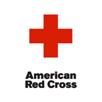
is testimony to just how sensitive (and what real value) an issue the use of
the Red Cross Symbol(s), is.
The Canadian Red Cross taking legal action to stop the use of the symbol in
computer games is another high profile example, saying:

"The
crux of the problem is that the misuse of the Red Cross in video games is
not only in contravention of the law, it also encourages others to believe
that the emblem of the Red Cross is `public property' and can be freely
used by any organization or indeed for commercial purposes."
The use of the symbol shown in this image is
regulated by certain international treaties, particularly the Hague
Conventions
of 1899 and 1907, the Geneva Conventions
of 1949 and their additional protocols of 1977 and 2005, as well as other
rules of International
Humanitarian
Law either in written agreements or by
long-standing customs. Misuse of this symbol is prohibited by these
treaties as well as by national law in all countries which have ratified
them. These restrictions are independent of the copyright
status of the depiction shown here.
Similarly in
the
UK
it is alleged that a Dodge
Ambulance on its way to a large MV gathering, was challenged because it
had its Red Crosses on display whilst on the public highway.

The concern
was that the crosses implied that the vehicle was an “active” in
service element offering humanitarian aid, when clearly it was not. The
issue seemed not to be that the MV was marked with a Red Cross, but that
it was displaying them in the public domain, implying that it was actually
involved in humanitarian duties. The compromise I understand agreed by
both parties was to have folding boards that hid the Red Cross symbol
whilst traveling to and from events. There seemed to be little interest
expressed in the vehicle displaying the symbol once in a display area,
perhaps in recognition of the re-enactment intention, and its good cause.
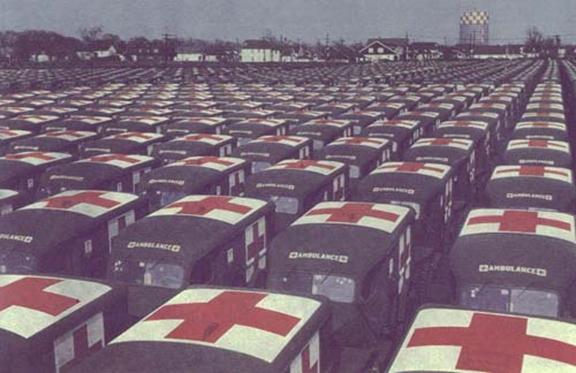
Articles 42
& 44 of the ‘49 Convention were quoted as the reason prohibiting the
“unofficial” use of the Red Cross Symbol:
Geneva
I, Art. 42, limits the display
of "the distinctive flag of the Convention" to medical units and
establishments entitled to be
respected under the Convention and permits it to be displayed in
conjunction with the national flag of the party to which the unit or
establishment belongs.
Geneva
I,
Art. 44, bans all uses of the
Red Cross or equivalent emblems (including flags) other than to indicate
or protect medical units and establishments and related personnel and
material under the Geneva Conventions, except that national Red Cross/Red
Crescent Societies may use the emblems in peacetime for other activities
in conformity with the principles of the Red Cross movement. In wartime,
they may use the emblems for their other activities only if they are
clearly not implying the protection of the convention. International Red
Cross organizations (such as the International Committee of the Red Cross)
may use the Red Cross emblem at all times.
A quick search of the internet came up with this statement from
About.Com: Web Clip Art:
"PLEASE NOTE: A Red Cross symbol is not a generic
symbol for first-aid, emergency, hospitals, healthcare or medical
services, products or personnel. The Red Cross symbol is a trademark owned
by the American Red Cross and protected by federal and state trademark
law, unfair competition law and anti-dilution law, and it is also
protected by federal criminal law (See 18 U.S.C. 706, 917). The American
Red Cross vigorously pursues those who infringe American Red Cross
trademarks".
Here in the
UK
, Dodges aside, there appears to be
something of a more relaxed mood, with the British
Red Cross promoting its name by offering Free “T” shirts bearing
the original Red Cross symbol, in fund raising events e.g.
London
and Manchester Runs etc. This use is no
doubt covered in Article 44, under other uses in peacetime: activities in conformity with the principles of the Red Cross movement.

However information on the British Red
Cross webby reveals dialogue from their Educational package:
http://www.redcross.org.uk/uploads/documents/Emblemak.doc
which makes their formal position quite
clear.
It is interesting to read forward from
the Performance sub heading,
where the terms: lawyer, breaking
the law, could be taken to court, misuse and entitlement, feature
prominently.
Perhaps there’s a clue here for the
UK re-enactor, display your Red Cross Symbol, correct to the MV or
reenactment scenario, on Dodge or what ever, but be sure to place a
collection tin along side and to return the funds to the British Red
Cross, then perhaps they will see the event as being another:
“….activity
in conformity with the principles of the Red Cross movement”, just
my thoughts.
Finally
and perhaps rather confusingly, due to
Geneva
's location in the
French-speaking part of
Switzerland
, it should be noted that the
ICRC usually acts under its French name: Comité
international de la Croix-Rouge (CICR).
The
official symbol of the CICR is the Red Cross on white background with the
French words "COMITE INTERNATIONAL GENEVE" circling the cross.

It seems
such a long way from the early days of that single: easily recognisable and universal sign of neutrality, of traveling
trucks, of field hospitals and their nurses, and Donut Dollies.

